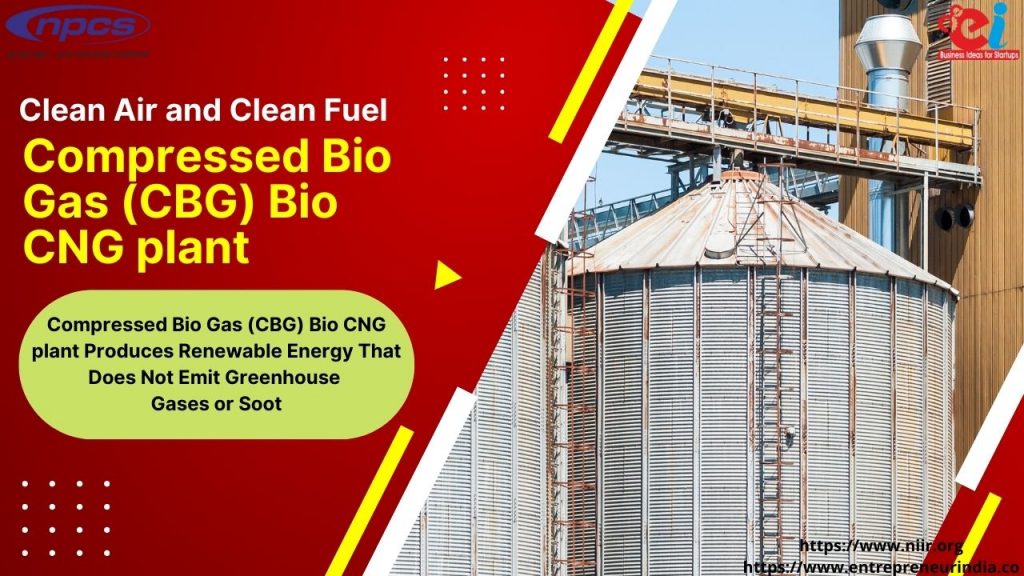A renewable energy source that can be utilized to generate electricity, power vehicles, and heat residences is compressed biogas.
Click here to send your queries/Contact Us
CBG plants are often constructed in rural locations with low population densities, such as sugar cane farms and rice fields. CBGs, often referred to as biogas plants, can be used to lower methane emissions, a particularly harmful greenhouse gas.
Visit this Page for More Information: Start a Business in Industrial Gases Industry
Uses and Application:
Compressed bio gas (CBG) facilities have a variety of uses and applications. They can be utilized in both fixed environments, like industries, hospitals, and schools, as well as mobile ones, like buses, trains, and ships. There are several uses for biogas.
Download Pdf: The Fuel of the Future Compressed Bio Gas CBG Bio CNG plant Save Money and Help save Our Planet with This Eco-Friendly Fuel
Combustion with a flame produced by the thermal breakdown of organic matter is used to generate heat or power. Because it contains methane, carbon dioxide, and hydrogen, it has been claimed that bio-gas has a higher calorific value than natural gas. Through the application of a catalyst, it can be transformed into syngas, which is mostly made up of hydrogen and carbon monoxide.
Related Business Plan: BIOGAS PRODUCTION
Manufacturing Process:
By utilizing anaerobic digestion to break down organic materials, compressed bio gas is produced. The biomass is first processed into a slurry and combined with water. Anaerobe bacteria are added to this slurry to break down the biomass without the need for oxygen. When the mixture is heated to between 60 and 65 degrees Celsius, a process occurs that yields solids like water, cellulose, and lignin as well as gases like methane and carbon dioxide. Two different forms of biogas are produced as a result of this procedure. Syngas is one form and it may be used in turbines exactly like natural gas. CNG and compressed biogas are the other types.
Read Similar Articles: INDUSTRIAL GASES PROJECTS
Benefits of Starting Compressed Biogas Plant Business:
- Create jobs in rural areas, boost economic growth, and encourage self-reliance.
- Generate renewable energy from food waste and agricultural waste while reducing greenhouse gas emissions.
- Produce natural gas fuel to power automobiles with fewer emissions, improving air quality. Use waste streams as the feedstock for renewable energy plants to reduce reliance on fossil fuels.
- Promote public health by doing away with coal-fired power plants Reduce dependence on petroleum by providing biofuel; Over time, save money owing to falling natural gas prices; Aside from using animal manure, this alternative income source is flexible enough to employ any sort of biomass, making it more ecologically benign than diesel generators and easier to start up with little initial expenditure.
Market Size in India:
Due to their high efficiency and low costs, compressed bio gas (CBG) or bio (CNG) facilities are anticipated to have a rapidly expanding market in the next years. CBGs had a $2.6 billion USD market value in 2016; by 2025, that market is expected to grow to $4.1 billion USD. The total revenue generated by CNGs worldwide in 2016 was $5.7 billion USD, and by 2025, it is anticipated to increase to over $9 billion USD. The fact that they operate more effectively than conventional gas-fired power production systems, which results in lower fuel costs and a decrease in greenhouse gas emissions, is one of the key elements driving this rapid development.
Related Feasibility Study Reports: Compressed Biogas – Manufacturing Plant, Detailed Project Report, Profile, Business Plan, Industry Trends, Market Research, Survey, Manufacturing Process, Machinery, Raw Materials, Feasibility Study, Investment Opportunities, Cost and Revenue
Global Market Outlook:
The market is anticipated to increase between 2021 and 2028 at a CAGR of 5.4%, from USD 25.61 billion in 2021 to USD 37.02 billion in 2028. The demand for and growth of this industry are the causes of the abrupt increase in CAGR. The increasing demand for cleaner fuels in the transportation sector, fluctuating oil costs, and growing concerns about climate change on a worldwide scale are to blame for this. By removing oxygen from the combination of gas, the plant converts biomass into biogas.
Read our Books Here: Handbook on Biogas and Its Applications (from Waste & Renewable Resources with Engineering & Design Concepts)(2nd Revised Edition)
Click here to send your queries/Contact Us
Before being utilized as fuel for automobiles, the compressed gas must first be introduced into pipelines at a high pressure of up to 2,500 pounds per square inch. Bio gas serves as the primary fuel for end user categories such as passenger cars, buses, Lorries, and vans, as well as agricultural machinery. Over the course of the anticipated period, this market is anticipated to expand significantly as more nation’s priorities environmental sustainability and make considerable investments in green technology.
See More Links:
- Start a Business in Asia
- Start a Business in Potential Countries for Doing Business
- Best Industry for Doing Business
- Business Ideas with Low, Medium & High Investment
- Looking for Most Demandable Business Ideas for Startups
- Startup Consulting Services
- Start a Business in Africa
- Start a Business in India
- Start a Business in Middle East
- Related Videos
- Related Books
- Related Projects
- Related Market Research Reports
